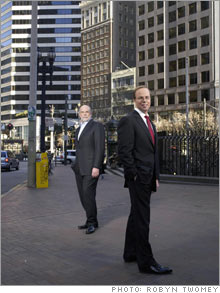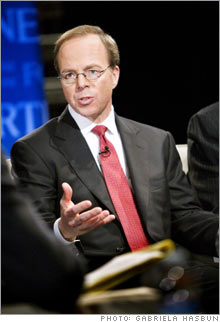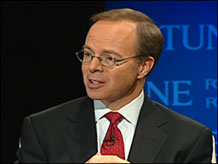McKesson: Wiring the medical worldFortune's Geoff Colvin sits down with the CEO and CIO of the health-care giant, who explain how information technology is finally ready to revolutionize the way we manage medicine.(Fortune Magazine) -- What's the biggest company in the biggest sector of the biggest economy on earth? You're forgiven if you don't know the answer: McKesson, America's largest health-care-services company, with revenues in fiscal 2006 of some $88 billion. It's a low-profile behemoth, in part because its core business, distributing pharmaceuticals, is not exactly fraught with romance. But McKesson (Charts) is in fact at the heart of one of America's largest and hottest issues, the efficiency of a health-care industry that consumes 17 percent of GDP and rising.
Much of the debate focuses on the use of information technology, where America's health-care sector trails far behind virtually all other industries. Infotech is critical to McKesson's strategy, not just in its core business but also in its many other lines, which include a wide range of software and hardware for hospitals, pharmacies and doctors' offices. For the first C-Suite Strategies interview of 2007, Fortune's Geoff Colvin went to McKesson's hometown and interviewed chief executive officer John Hammergren and chief information officer Randy Spratt before an invited audience at the San Francisco Museum of Modern Art. Among other things, they talked about what infotech can do for health care, the security of electronic medical records, and how to make doctors who got C's in medical school more like those who got A's. Edited excerpts: America's use of infotech in health care has been very widely criticized, and even President Bush called for it to be improved in his State of the Union speech three years ago. A RAND Corp. study found that better use of infotech in health care could save $162 billion a year. So why isn't that happening? Hammergren: I think it is happening. It's happening probably now more than ever. The adoption rate is accelerating for technology at the hospital level and the physician's office level, and I think attention from the media, the President and others has allowed that adoption to accelerate. And there is evidence that it's producing better results from a quality perspective and a cost perspective. In the next five or six years consumers will see a tremendous impact from that implementation of technology. On the other hand, Randy, most industries achieved this level of infotech use years ago. Why has it taken longer in this business? Spratt: It's certainly true that it has taken longer. I think we need to give the industry credit, though, for the ability to push the envelope toward adoption. It's these basic technologies that are paving the way for more of the complex capabilities that we strive for - certain things like bar coding. If you walk into a grocery store anywhere in the U.S., the same loaf of bread is going to get scanned the same way, and that scan will echo up and down the supply chain, automatically ordering, adjusting inventory control and the like. But less than 20 percent of hospitals today have a fully bar-coded medication-dispensing system for something as critical to care as a dose of pharmaceuticals. Including putting a bar code on the patient, right? Hammergren: It's a wristband, not a tattoo. Spratt: The key part of dispensing medication is making sure you're delivering the right medication at the right time to the right patient. If we can verify electronically in all three of those steps, we've gone a long way toward eliminating a very substantial cause of medication error. Why has it taken so long? Part of it is standards. We've been slow to create the nationwide standards necessary for vendors to build their systems. Second, frankly, it's access to capital. Hospitals operate on razor-thin margins. It's very difficult for them to obtain the capital to deploy these systems and make all the changes in the processes needed to support it. But in the past five years we're starting to see great examples of driving improvements in patient safety, saving many, many lives from the 300,000 or so medication errors that medication systems catch every week. Consumers now shop for almost everything online, but if they try to shop online for health care, they don't get too far. What is going to change that? Spratt: Today the consumer can see outcomes of selected disease states from local care providers and compare them. But they still can't actually interact with the health-care system - use Web-based media to interact with their physician. We've got pretty clear evidence that online physician office visits provide a very tangible benefit. The patient can deal with filling out forms and basic intake without having to travel to the doctor's office. The physician is presented with a well-organized display of that information and can rapidly determine whether that patient needs a follow-up visit or if he can prescribe an appropriate medication. Payers are recognizing that there's a benefit there. Hammergren: We're focused on creating common views of data that are customized by individual constituents. So, for example, I don't want you to maintain the med list yourself as a patient; I want to have a common med list that the doctors share, the pharmacist shares, and you share. Those lists may be presented differently to you than they would be presented to the doctor. One of the great objectives of improving infotech in health care is making all patient records available electronically to whoever may need them. So even if you have a car accident in another state, the emergency room can go online and know everything it needs to know about you. How close are we to that? Hammergren: It's really not a technological barrier. The systems are available, and we can provide those interconnections. The issue is one of adoption. Are people really ready to do this? Are the emergency rooms automated? Are the physicians' offices automated? And frankly, is our society ready for people's information to be available in a more ubiquitous way? I think that is still a question mark. But technologically speaking, we're there. Randy, are medical data in fact technologically safe and secure? Spratt: It's as safe and secure as any information stored in any system can be. There's a whole body of law that controls how patient information can be used and stored, and the access to that information. Obviously that information needs to be available to physicians and primary-care staff if they're going to take advantage of it. So along with those records needs to travel the access rights that the patient grants for use of those records. Will someone ever view a medical record that perhaps they shouldn't have? They probably will, but in an electronic world we'll know that it happened. We'll know who did it, which is far superior to a chart lying around on a nurse's station for anybody to walk by and glance at. So the issue is not technology; the issue really is people getting comfortable with a new way of doing things. Hammergren: Right. If they trust their banking information in a bank, they're eventually going to have to trust their health information outside the file folder. And if they don't, that's fine, but having an emergency health issue dealt with in Florida when you live in California is not going to be possible if that information is not made available. Will people trust electronic prescriptions? Spratt: I would hope so, and the adoption is already beginning. It'll provide tremendous convenience, plus it'll provide a track record. As a physician I don't know when I hand you the prescription whether you ever have it filled. In the future, the physician will get a signal that you've actually picked up your medication. The issue is time, the workflow of the physician. As long as it's easier to script it out and hand it to a voice-activated nurse, that's what the physician will do. But with advanced physician tools we can provide enough assistance, enough guidance, enough insight to reference materials that physicians are actually drawn to the tool and see it as a preferable way to prescribe. So in those institutions that have those tools, the electronic prescribing is near 100 percent. Did you say voice-activated nurse? Does that mean a person you can tell what to do? Spratt: It does (laughing). Your core business of pharmaceutical distribution is a low-margin business. What can other companies learn from you about efficiency and cost cutting? Hammergren: It's a combination of a way of thinking, a culture and the deployment of technology to leverage your people. Our biggest cost in pharmaceutical distribution, setting aside the fixed asset, is the variable labor associated with picking and processing the orders. So we can reduce the variability in those operations through things such as Six Sigma, which we've been doing for ten years, and then install technology as the underpinning. So we have great visibility when somebody's a performance outlier, or a distribution center is a performance outlier. And we've got great customers like Wal-Mart that are very demanding and that over the years have not allowed us to grow our cost and our pricing but have helped us learn how to be extremely efficient. Sounds like a big role for you, Randy, because more and better infotech is going to make these operations more efficient, right? Spratt: It certainly plays a major role, but the trick is to find exactly where and how to apply that technology. We have a very strong culture around process improvement, and we engage our Six Sigma teams in driving variability and defects out of the millions of doses that we deliver. They find what would appear to be extremely small changes of the process that in many cases mean an enhancement. The IT is the solution to the process improvement. So IT isn't the driver, IT is the response. You have a business where IT is central to the strategy, and in an information-based economy like ours, more and more companies are in exactly that position - which makes the relationship between CEO and CIO critically important. So what's your relationship? How often do you talk? Hammergren: By e-mail we talk constantly, seven days a week. We're very connected, and clearly Randy is technically more skilled than I am. He has the ability to dummy down the technology into more business-focused conversations around means and requirements. I also think he's done a great job bringing our skills up on the management side of the business to understand what technology is and what it isn't. It's not just about buying the stuff, it's about how we are going to implement, and what is it going to do to the process. It's a different mindset. Spratt: The ability to deploy IT effectively is ultimately a balance of risk to the business and benefit to the business. John understands the risk side and the rewards side and will go through a review of a new technology, a new proposal, a new project, just as you would go through a business review. So while he may not have the deep training and the deep background, if we can't find business benefit and the business reason to do something, we're probably not going to spend the time on it. You've spent your careers in this industry. Based on your knowledge, do you do things personally that help you or your family use the health-care system that somebody else might not do? Hammergren: I think we probably understand the risks of the health-care system, the variability of the health-care system, living in it more than others do. To say there might be medication errors occurring in hospitals at a magnitude that's measurable might shock some people. We know it's a problem, and it's existed for a long time. So I think we're probably more suspicious. Spratt: As we travel around the U.S., we visit hundreds of facilities, and we build relationships. As my family goes through health-care events, I've found it's of tremendous value to pick up the phone and say, "What is the latest approach to this?" "How are you doing this?" It's unusual access, but to John's point, you don't take for granted that when you walk in those doors, you're going to be safe. Hammergren: The problem with that is, it's not scalable for 300 million Americans. So we have to reduce the variability in the operations. The distance between the best doctor and the worst doctor has to come together; the difference between the worst hospital and the best hospital has to come together. And a way to do that, I believe, is to provide systems to support best practices. We're talking about getting inside physicians' minds while they're making the treatment decision to get them information about the best demonstrated practice treating, say, pneumonia. Maybe we're in San Francisco and they're in Utah, but there's no reason they can't get access to thinking around the globe on the best way to treat whatever. So we can move the person who got C's in med school and the person who got A's in med school together, and you get better outcomes. This is the latest interview by Fortune senior editor at large Geoff Colvin with business's top executives. See video excerpts of this interview, plus find out how FedEx CIO Rob Carter gets it there on time, how former Best Buy CMO Michael Linton views 21st-century marketing, and how P&G CEO A.G. Lafley and GE CEO Jeffrey Immelt find billions in sales growth each year. From the February 19, 2007 issue
|
Sponsors
| ||||||||||||||||||||||||




